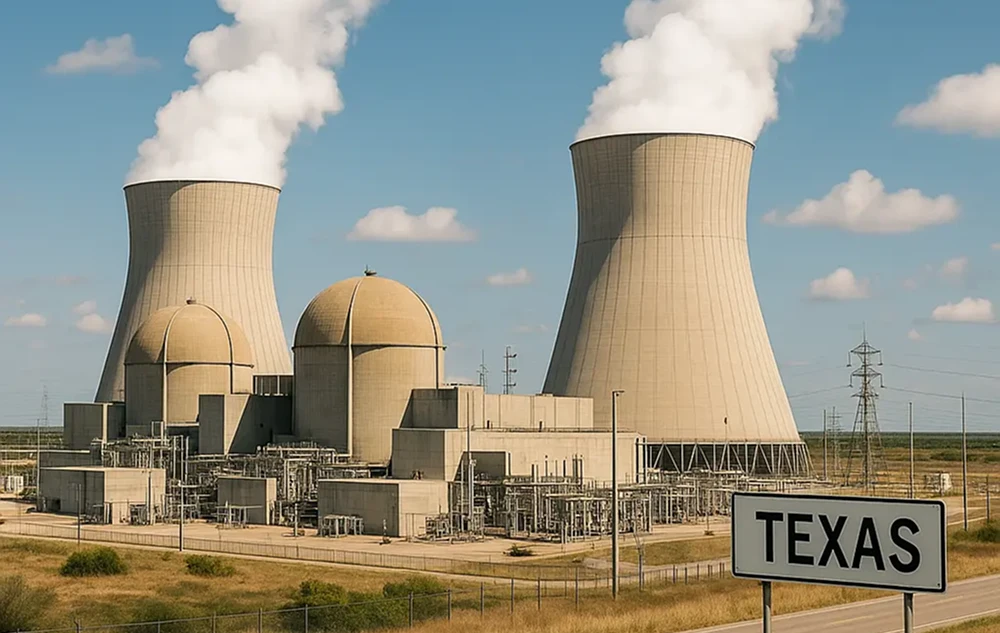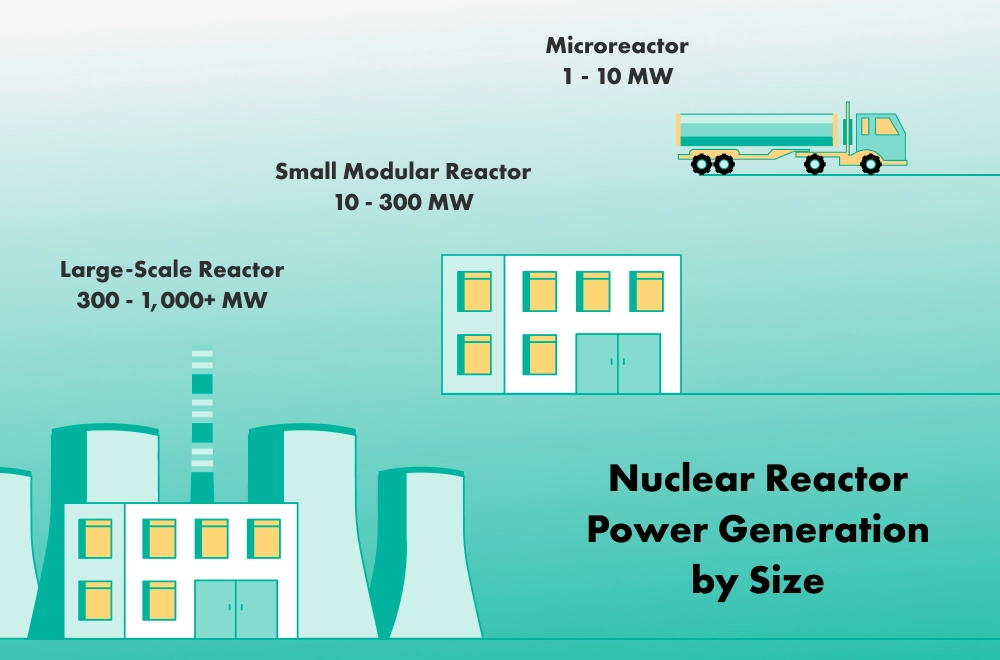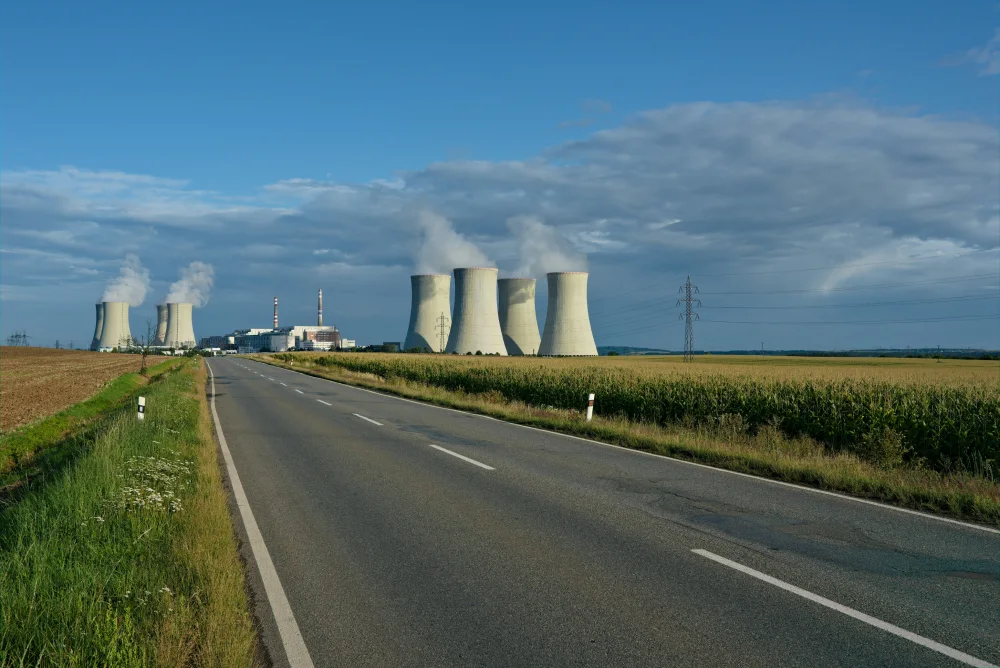What Are Small Modular Reactors?
5 minute readIt’s no secret that global concerns over climate change have escalated in recent years. But what you might not know
Home > Learning Center > Energy Production > Environmental Impact of Nuclear Energy
Nuclear energy offers low emissions and reliable power, but it also raises concerns about waste, water use, and safety.
4 minute read • Last update July 2025

Nuclear energy presents a complex environmental profile, balancing its role as a low-carbon power source with significant trade-offs, including radioactive waste, thermal pollution, and the potential for catastrophic failure.
As the global energy mix shifts away from fossil fuels, nuclear power remains one of the few scalable, non-intermittent alternatives. Understanding its full environmental impact is critical to informed energy policy and public acceptance.
Nuclear energy is among the lowest-carbon energy sources over its full lifecycle. With average lifecycle CO₂-equivalent emissions around 12 grams per kilowatt-hour, it rivals wind energy and outperforms solar. This includes mining, construction, operation, and decommissioning.
Nuclear power plants deliver exceptionally high energy output on a compact physical footprint. According to a life‑cycle land‑use comparison by Our World in Data, nuclear requires around 50 times less land per MWh than coal and 18–27 times less than ground‑mounted solar PV.
Wind farms are even more land‑intensive due to turbine spacing requirements. This high power density means nuclear plants significantly reduce the need for land conversion and habitat disruption compared to large-scale solar and wind installations.
Fission reactors do not rely on combustion. As a result, they release no direct carbon dioxide or other greenhouse gases during electricity generation, helping mitigate climate change at the operational level.
Nuclear reactors require constant cooling, often using nearby rivers or lakes. The discharge of heated water can disrupt aquatic ecosystems by altering oxygen levels and species composition if not properly managed.
Nuclear fission generates high-level radioactive waste that remains hazardous for thousands of years. Long-term geologic storage solutions, like the Yucca Mountain site in Nevada, have faced political and logistical obstacles, leaving spent fuel stored on-site at reactors across the U.S.
While rare, nuclear accidents like Chernobyl (1986) and Fukushima (2011) demonstrate the potential for high-consequence environmental damage. These incidents released radioactive isotopes into the air, water, and soil, requiring decades of remediation.
Uranium extraction emits dust, radon gas, and chemical waste. According to the U.S. National Library of Medicine report, “large quantities of waste rock at a mining operation will emit radon and may generate wind‑blown particulates if dust controls are not in place.”
Construction, operation, and decommissioning of nuclear power plants require large volumes of reinforced concrete and steel, contributing to embedded carbon emissions across the plant’s lifecycle. Over 95% of material-related energy input occurs during construction, primarily from concrete and steel production.
While nuclear plants typically operate for 40 to 60 years, many are now reaching retirement age. More than 190 reactors have been permanently shut down worldwide, and decommissioning activity is expected to increase in the coming decades.
Although nuclear reactors require significant cooling water, their freshwater consumption per megawatt-hour is lower than that of coal or oil-fired power plants, particularly when using closed-loop or dry cooling systems.
A study by the National Renewable Energy Laboratory found that closed-loop nuclear systems consume about 672 gallons per MWh, which is comparable to coal, while once-through systems withdraw up to 44,350 gallons per MWh but only consume around 269 gallons.
Next-generation nuclear technologies like Small Modular Reactors (SMRs) and closed-fuel cycles aim to reduce radioactive waste, land use, and accident risk. SMRs are factory-built and compact, allowing for faster deployment, enhanced safety, and potential integration with fuel recycling systems.
Advanced reactor designs can even reuse long-lived waste as fuel, shortening the radioactive lifespan of byproducts. These innovations could make nuclear power more efficient, scalable, and environmentally sustainable, similar to how binary-cycle systems transformed geothermal energy.
Nuclear energy does not produce combustion-based pollutants like sulfur dioxide, nitrogen oxides, or carbon monoxide. However, it does result in radioactive and thermal pollution, particularly from waste storage and water discharge.
The degree of environmental impact hinges on the effectiveness of fuel cycle management, site-specific design, and safety protocols.
Nuclear energy is not inherently bad for the environment, but it requires rigorous management of long-term risks. It delivers massive emissions reductions and stable baseload power, offsetting fossil fuels and improving air quality. At the same time, it introduces environmental challenges that renewables like wind and solar largely avoid.
Compared to coal or natural gas, nuclear is environmentally superior in terms of carbon emissions and particulate pollution. However, the presence of radioactive waste and the risk of severe, long-duration accidents complicate its environmental value proposition. Responsible deployment depends on modern reactor design, regulatory oversight, and investment in long-term waste disposal solutions.
| Positive Environmental Aspects | Negative Environmental Trade-offs |
|---|---|
| Ultra-low greenhouse gas lifecycle profile | Long-lived radioactive waste with no permanent storage solution |
| Compact land use | Thermal discharge affecting aquatic ecosystems |
| Stable, non-intermittent baseload generation | Low-probability, high-impact accident scenarios |
| No air pollution from combustion or particulates | Mining and enrichment-related ecological degradation |
| Carbon footprint from construction and decommissioning |
Small Modular Reactors (SMRs) represent a promising evolution in nuclear technology. With modular construction and passive safety systems, SMRs can be deployed more quickly and at a lower upfront cost compared to conventional large-scale reactors. Their compact design also offers the potential for reduced radioactive waste and more flexible siting options.
Advanced nuclear technologies such as Generation IV reactors and closed-fuel cycles further enhance sustainability by improving fuel efficiency and significantly reducing long-lived waste. Concepts like molten salt and fast breeder reactors could reshape the energy landscape by recycling spent fuel and lowering proliferation risks.
However, the future of nuclear energy hinges not only on technological advancements but also on public confidence and regulatory clarity. Transparent policies, effective oversight, and active community engagement will be essential for building support, particularly in regions near proposed development sites.
Q: Is nuclear power sustainable long-term?
A: With advancements in fuel recycling and next-gen reactors, nuclear has potential for long-term sustainability—but only with robust waste solutions and responsible oversight.
Q: What happens to radioactive waste?
A: Spent nuclear fuel is stored in pools or dry casks at reactor sites. Long-term geologic repositories are under development but face political and technical delays.
Q: Can nuclear accidents be prevented entirely?
A: While modern reactors are designed with multiple safety layers, no system is entirely immune to failure. Prevention relies on design integrity, operational discipline, and emergency preparedness.
Graham Lumley, Digital Marketing Manager at BKV Energy, leads digital and traditional marketing strategies, focusing on educating Texans about the state's deregulated energy market. With over 8 years of marketing experience, he creates content to help consumers understand and save on their energy bills, bringing a fresh and dynamic approach to the industry.

It’s no secret that global concerns over climate change have escalated in recent years. But what you might not know

Discover the different types of nuclear power plants and how they work
Get $50 off your electric bill!
Use code BKVEJOINUS50
Enter your zip code to shop BKV Energy's affordable, fixed-rate Texas electricity plans. Use the promo code for $50 off your electric bill.